The Influence of N-Acetyl-selenomethionine on Two RONS-Generating Cancer Cell Lines Compared to N-Acetyl-methionine
Abstract
1. Introduction
2. Materials and Methods
2.1. Materials
2.2. Cell Culture
2.3. Cell Proliferation Experiments
2.4. Cytotoxicity Assay
2.5. Caspase-3 Activity Measurements
2.6. Statistical Analysis
3. Results
3.1. Jurkat Cell Lines
3.1.1. Cell Proliferation Experiment
3.1.2. Mitochondrial Activity of Jurkat Cell Lines in Presence or Absence of NASeLM or NALM
3.1.3. Caspase-3 Activated Apoptosis Measurements of Jurkat Cell Lines in Presence or Absence of NASeLM or NALM
3.2. MTC-SK Cell Lines
3.2.1. Cell Proliferation Experiment
3.2.2. Mitochondrial Activity of MTC-SK Cells in Presence or Absence of NASeLM or NALM
3.2.3. Caspase-3 Activated Apoptosis Measurements of MTC-SK Lines in Presence or Absence of NASeLM or NALM
4. Discussion
5. Conclusions
Author Contributions
Funding
Institutional Review Board Statement
Informed Consent Statement
Data Availability Statement
Acknowledgments
Conflicts of Interest
References
- Radomska, D.; Czarnomysy, R.; Radomski, D.; Bielawski, K. Selenium Compounds as Novel Potential Anticancer Agents. Int. J. Mol. Sci. 2021, 22, 1009. [Google Scholar] [CrossRef] [PubMed]
- Bartolini, D.; Sancineto, L.; de Bern, A.F.; Tew, K.D.; Santi, C.; Radi, R.; Toquato, P.; Galli, F. Chapeter Ten—Selenocompounds in cancer therapy: An overview. Adv. Cancer Res. 2017, 136, 259–302. [Google Scholar] [CrossRef] [PubMed]
- Hariharan, S.; Dharmaraj, S. Selenium and selenoproteins: It’s role in regulation of inflammation. Inflammopharmacology 2020, 28, 667–695. [Google Scholar] [CrossRef] [PubMed]
- Ge, S.; Zhao, J.; Yao, J.; Fu, H.; Tian, Y.; Shan, Y.; Sun, M.; Feng, J.; Dong, J.; Liao, L. The association between serum selenium levels and pathological features of papillary thyroid cancer in 284 patients. Front. Endocrinol. 2023, 14, 1242250. [Google Scholar] [CrossRef] [PubMed]
- Connelly-Frost, A.; Poole, C.; Satia, J.A.; Kupper, L.L.; Millikan, R.C.; Sandler, R.S. Selenium, folate, and colon cancer. Nutr. Cancer 2009, 61, 165–178. [Google Scholar] [CrossRef]
- Cai, X.; Wang, C.; Yu, W.; Fan, W.; Wang, S.; Shen, N.; Wu, P.; Li, X.; Wang, F. Selenium Exposure and Cancer Risk: An Updated Meta-analysis and Meta-regression. Sci. Rep. 2016, 6, 19213. [Google Scholar] [CrossRef] [PubMed]
- Rataan, A.O.; Geary, S.M.; Zakharia, Y.; Rustum, Y.M.; Salem, A.K. Potential Role of Selenium in the Treatment of Cancer and Viral Infections. Int. J. Mol. Sci. 2022, 23, 2215. [Google Scholar] [CrossRef] [PubMed]
- Garland, M.; Morris, J.S.; Stampfer, M.J.; Colditz, G.A.; Spate, V.L.; Baskett, C.K.; Rosner, B.; Speizer, F.E.; Willett, W.C.; Hunter, D.J. Prospective study of toenail selenium levels and cancer among women. J. Natl. Cancer Inst. 1995, 87, 497–505. [Google Scholar] [CrossRef] [PubMed]
- Chen, Y.C.; Prabhu, K.S.; Mastro, A.M. Is selenium a potential treatment for cancer metastasis? Nutrients 2013, 5, 1149–1168. [Google Scholar] [CrossRef] [PubMed]
- Wanders, D.; Hobson, K.; Ji, X. Methionine Restriction and Cancer Biology. Nutrients 2020, 12, 684. [Google Scholar] [CrossRef] [PubMed]
- Greilberger, J. Preclinical and Clinical Testing of an Alpha-Ketoglutarate/5-HMF/N-actyl-selenomethionine and N-acteyl-methionine for Treating Tumors. In Proceedings of the 3rd World Congress on Cancer Science & Therapy, Burlingame, CA, USA, 21–23 October 2013; 1948. [Google Scholar]
- Curnock, A.P.; Thomson, T.A.; Westwood, R.; Kuo, E.A.; Williamson, R.A.; Ja, C.M.; Ruuthb, E. Inhibition of stimulated Jurkat cell adenosine 3′,5′-cyclic monophosphate synthesis by the immunomodulatory compound HR325. Biochem. Pharmakol. 2001, 61, 227–235. [Google Scholar] [CrossRef] [PubMed]
- Pfragner, R.; Höfler, H.; Behmel, A.; Ingolic, E.; Walser, V. Establishment and characterization of continuous cell line MTC-SK derived from a human medullary thyroid carcinoma. Cancer Res. 1990, 50, 4160–4166. [Google Scholar] [PubMed]
- Greilberger, J.; Herwig, R.; Greilberger, M.; Stiegler, P.; Wintersteiger, R. Alpha-Ketoglutarate and 5-HMF: A Potential Anti-Tumoral Combination against Leukemia Cells. Antioxidants 2021, 10, 1804. [Google Scholar] [CrossRef] [PubMed]
- Greilberger, J.; Erlbacher, K.; Stiegler, P.; Wintersteiger, R.; Herwig, R. Different RONS Generation in MTC-SK and NSCL Cells Lead to Varying Antitumoral Effects of Alpha-Ketoglutarate + 5-HMF. Curr. Issues Mol. Biol. 2023, 45, 6503–6525. [Google Scholar] [CrossRef] [PubMed]
- Rua, R.M.; Nogales, F.; Carreras, O.; Ojeda, M.L. Selenium, selenoproteins and cancer of the thyroid. J. Trace Elem. Med. Biol. 2023, 76, 127115. [Google Scholar] [CrossRef]
- Mecham, J.O.; Rowitch, D.; Wallace, C.D.; Stern, P.H.; Hoffman, R.M. The metabolic defect of methionine dependence frequently occurs in human tumour cell lines. Biochem. Biophys. Res. Comm. 1983, 117, 429–434. [Google Scholar] [CrossRef] [PubMed]
- Guo, H.Y.; Herrera, H.; Groce, A.; Hoffman, R.M. Expression of the biochemical defect of methionine dependence in fresh patient tumours in primary histoculture. Cancer Res. 1993, 53, 2479–2483. [Google Scholar] [PubMed]
- Tripodi, F.; Badone, B.; Vescovi, M.; Milanesi, R.; Nonnis, S.; Maffioli, E.; Bonanomi, M.; Gaglio, D.; Tedeschi, G.; Coccetti, P. Methionine supplementation affects metabolism and reduces tumour aggressiveness in liver cancer cells. Cells 2020, 9, 2491. [Google Scholar] [CrossRef] [PubMed]
- Ventura, M.; Melo, M.; Carrilho, F. Selenium and Thyroid Disease: From Pathophysiology to Treatment. Int. J. Endocrinol. 2017, 2017, 1297658. [Google Scholar] [CrossRef] [PubMed]
- Pan, R.; Zhao, J.; Yao, J.; Gao, Y.; Liao, L. Selenomethionine Suppress the Progression of Poorly Differentiated Thyroid Cancer via LncRNA NONMMUT014201/miR-6963-5p/Srprb Pathway. Comb. Chem. High Throughput Screen. 2024; ahead of print. [Google Scholar] [CrossRef]
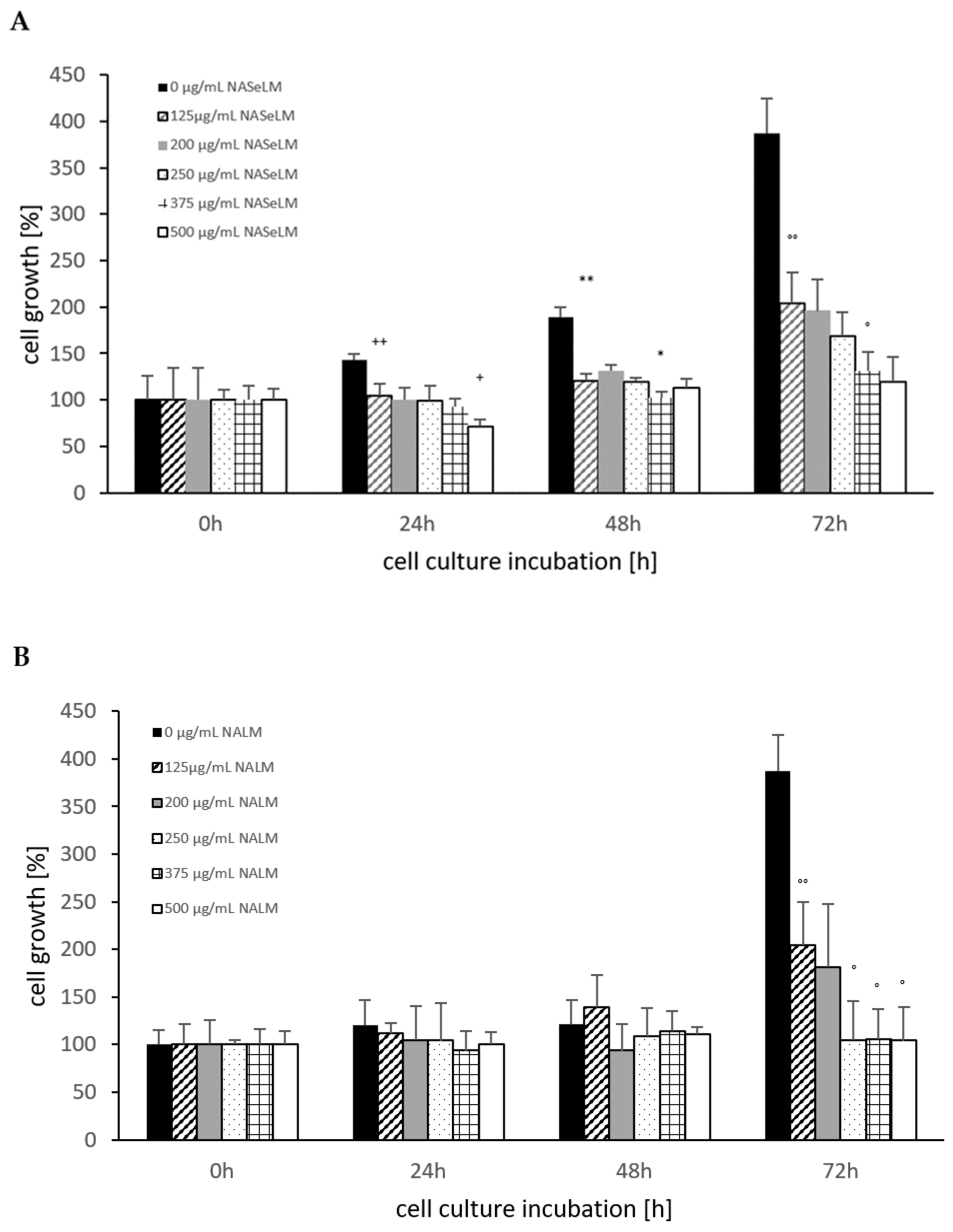
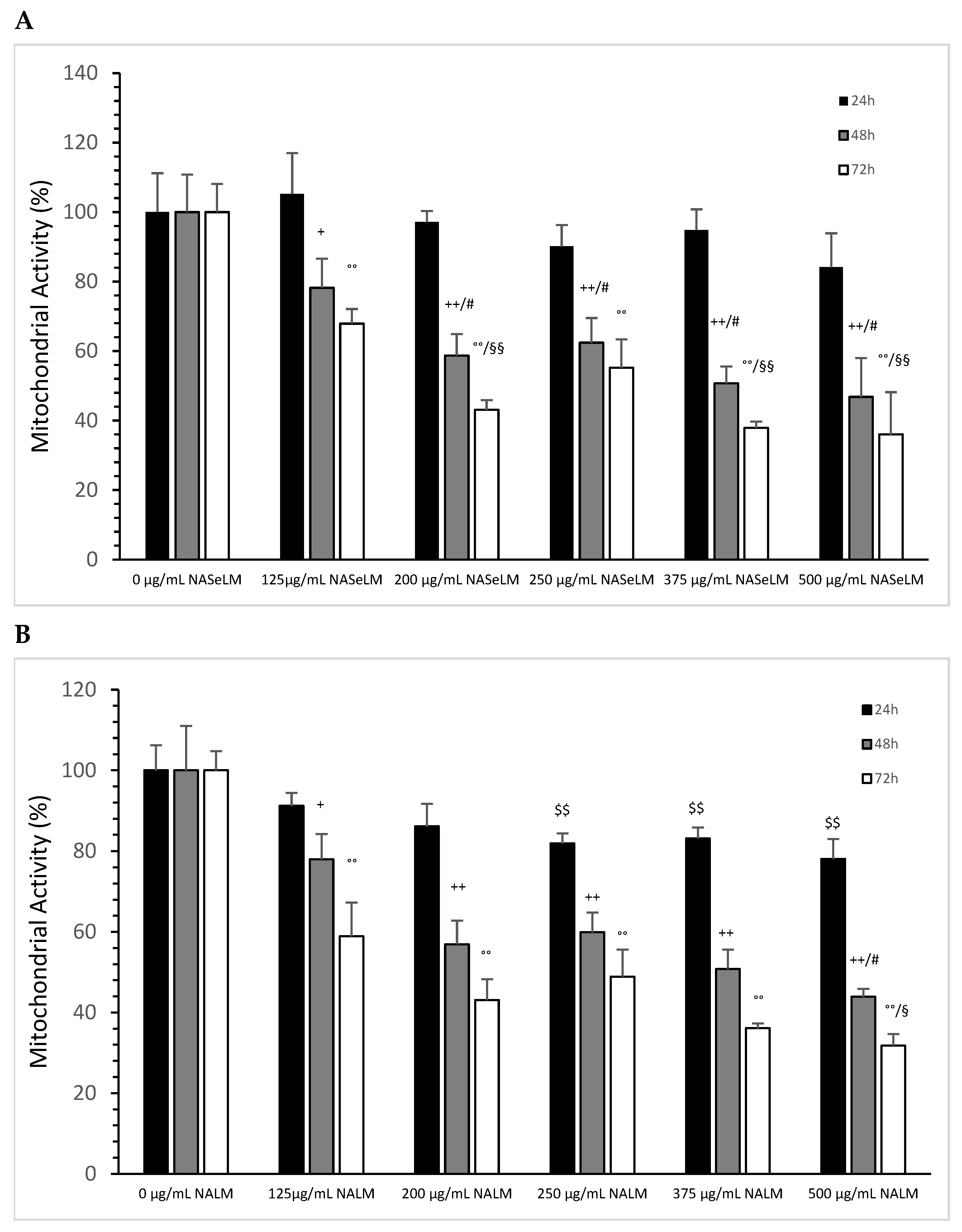
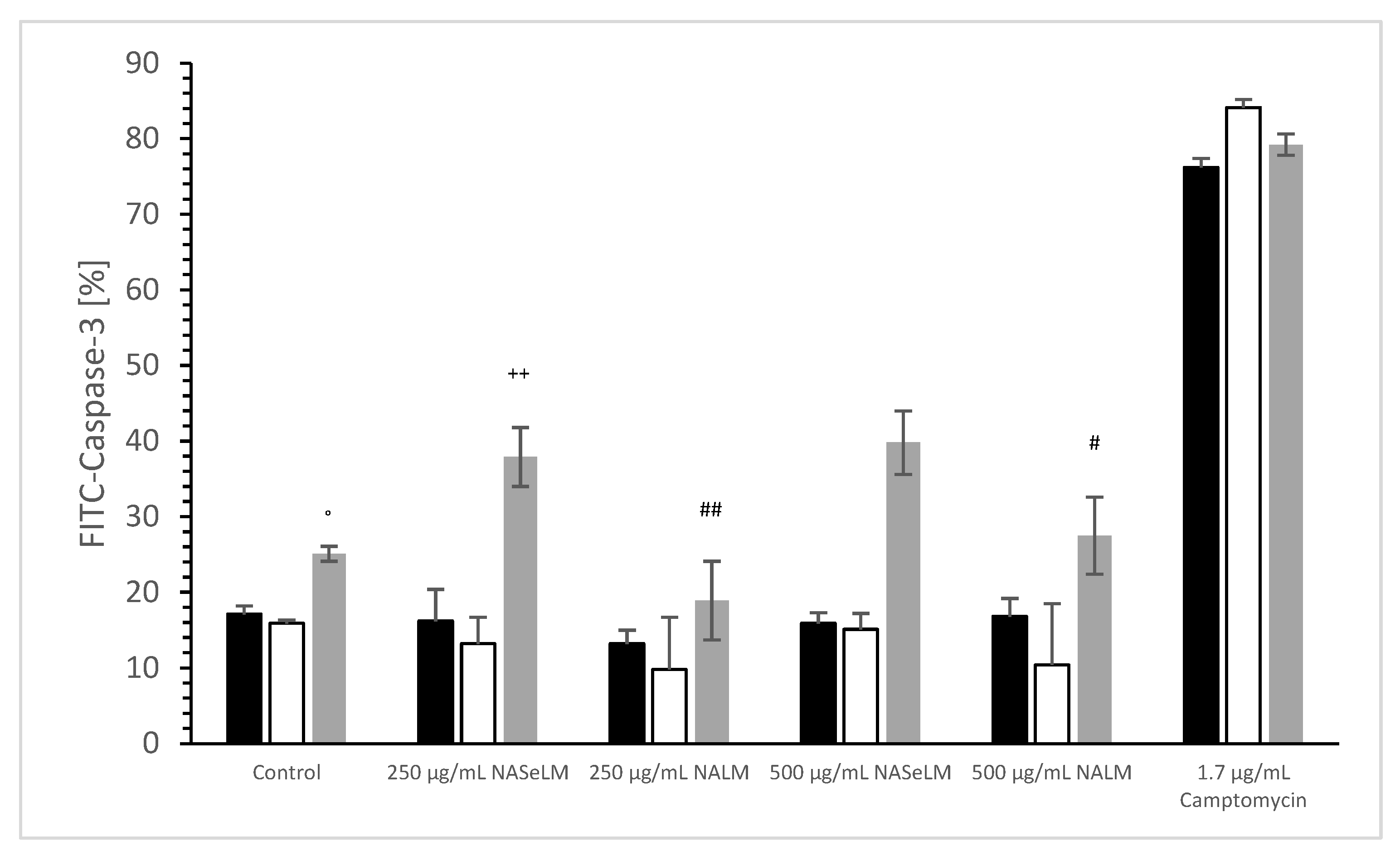

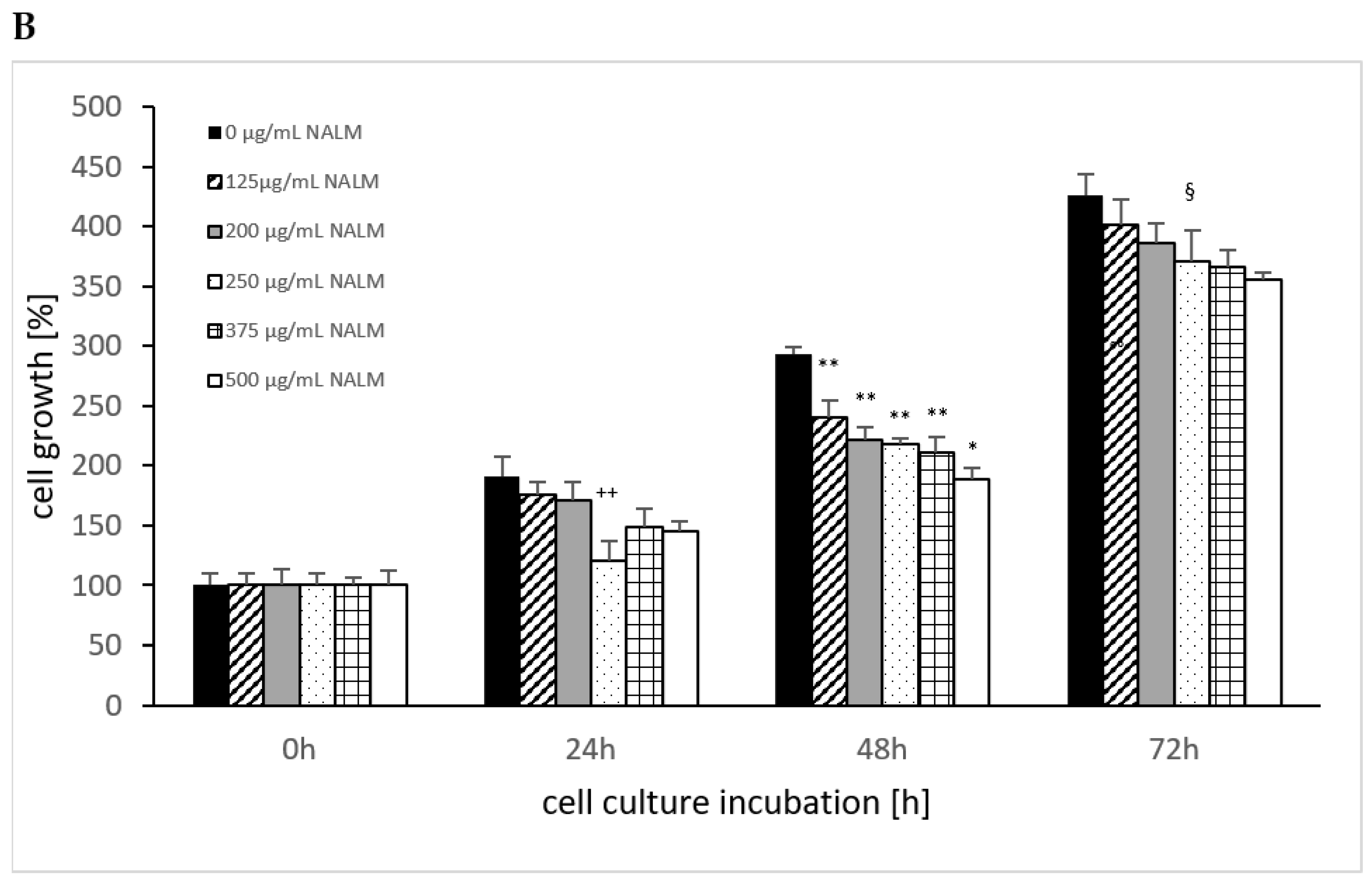
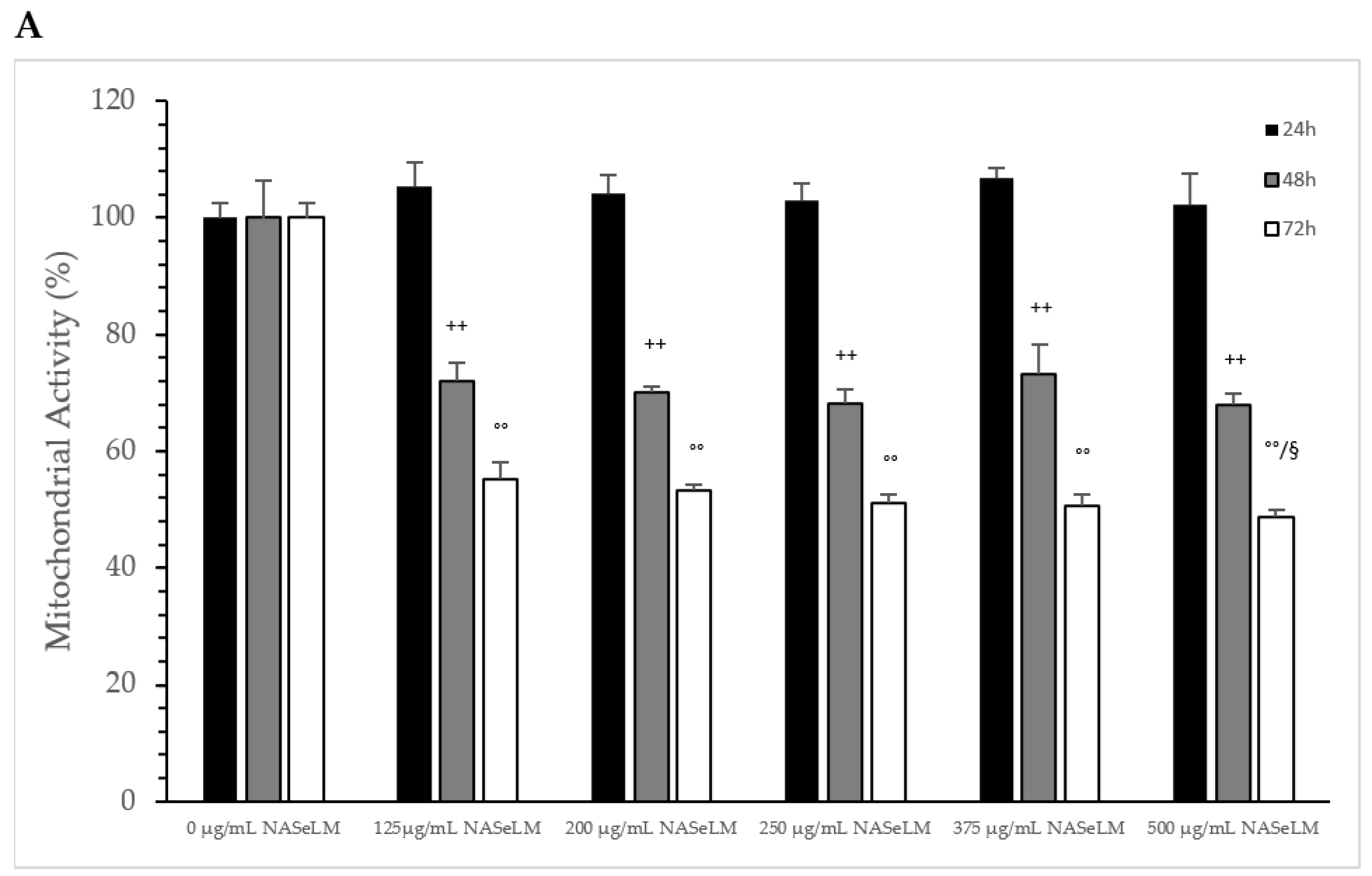

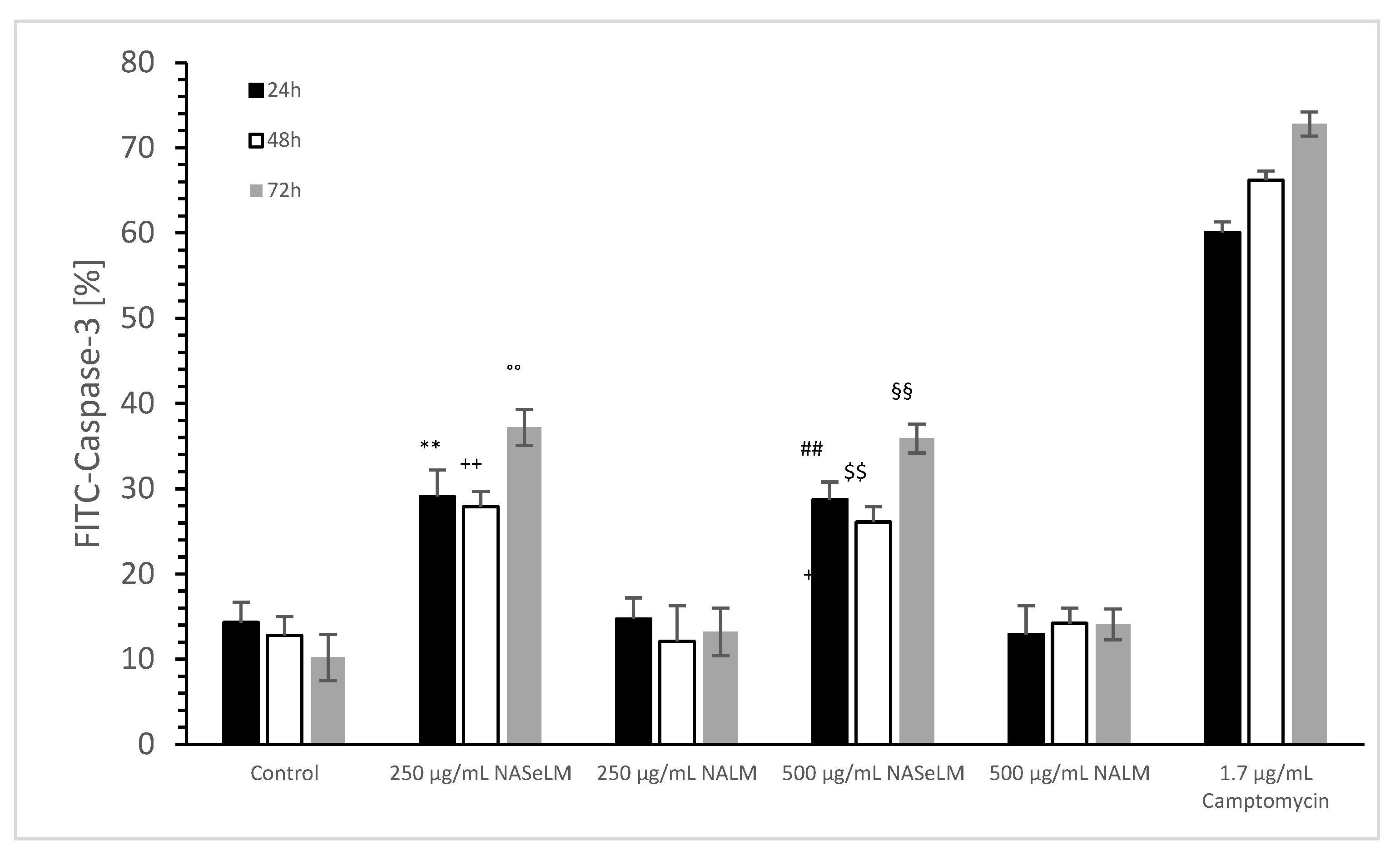
| Cell Growth | 48 h | p | 72 h |
|---|---|---|---|
| % | % | ||
| 125 µg/mL NASeLM | 121.0 +/− 12.5 | ns | 204.0 +/− 41.0 |
| 125 µg/mL NALM | 139.4 +/− 33.5 | 204.0 +/− 46.0 | |
| 200 µg/mL NASeLM | 131.0 +/− 7.0 | ns | 196.0 +/− 33.5 |
| 200 µg/mL NALM | 93.5 +/− 28.0 | 181.5 +/− 66.0 | |
| 250 µg/mL NASeLM | 119.0 +/− 4.5 | ns | 169.0 +/− 25.5 |
| 250 µg/mL NALM | 109.0 +/− 29.0 | 104.5 +/− 41.0 | |
| 375 µg/mL NASeLM | 102.5 +/− 6.0 | ns | 131.0 +/− 21.0 |
| 375 µg/mL NALM | 114.0 +/− 21.0 | 106.0 +/− 31.0 | |
| 500 µg/mL NASeLM | 113.5 +/− 9.0 | ns | 119.0 +/− 27.5 |
| 500 µg/mL NALM | 110.5 +/− 7.5 | 104.0 +/− 35.5 |
| Mitochondrial Activity | 48 h | p | 72 h | p |
|---|---|---|---|---|
| % | % | |||
| 125 µg/mL NASeLM | 78.2 +/− 8.4 | ns | 67.9 +/− 4.2 | ns |
| 125 µg/mL NALM | 78.0 +/− 6.2 | 58.9 +/− 8.4 | ||
| 200 µg/mL NASeLM | 58.7 +/− 6.2 | ns | 43.1 +/− 2.8 | ns |
| 200 µg/mL NALM | 56.9 +/− 5.9 | 43.1 +/− 5.2 | ||
| 250 µg/mL NASeLM | 62.4 +/− 7.1 | ns | 55.2 +/− 8.2 | ns |
| 250 µg/mL NALM | 59.9 +/− 4.9 | 48.9 +/− 6.7 | ||
| 375 µg/mL NASeLM | 50.7 +/− 4.9 | ns | 37.9 +/− 1.8 | ns |
| 375 µg/mL NALM | 50.8 +/− 4.8 | 36.1 +/− 1.2 | ||
| 500 µg/mL NASeLM | 46.8 +/− 11.2 | ns | 36.0 +/− 12.2 | ns |
| 500 µg/mL NALM | 43.9 +/− 2.0 | 31.8 +/− 2.9 |
| Cell Growth | 48 h | p | 72 h | p |
|---|---|---|---|---|
| % | % | |||
| 125 µg/mL NASeLM | 178.5 +/− 14.0 | 0.02 | 216.0 +/− 12.5 | <0.001 |
| 125 µg/mL NALM | 240.5 +/− 14.0 | 401.0 +/− 21.0 | ||
| 200 µg/mL NASeLM | 172.5 +/− 11.0 | 0.009 | 191.0 +/− 17.0 | <0.001 |
| 200 µg/mL NALM | 221.0 +/− 16.0 | 386.0 +/− 17.1 | ||
| 250 µg/mL NASeLM | 169.0 +/− 4.5 | <0.001 | 196.0 +/− 20.1 | <0.001 |
| 250 µg/mL NALM | 218.0 +/− 4.1 | 371.0 +/− 18.5 | ||
| 375 µg/mL NASeLM | 151.0 +/− 14.0 | 0.005 | 189.0 +/− 14.5 | <0.001 |
| 375 µg/mL NALM | 210.5 +/− 14.2 | 366.0 +/− 13.9 | ||
| 500 µg/mL NASeLM | 139.0 +/− 9.0 | 0.002 | 196.0 +/− 27.5 | <0.001 |
| 500 µg/mL NALM | 189.0 +/− 9.8 | 355.5 +/− 5.5 |
| Mitochondrial Activity | 48 h | p | 72 h | p |
|---|---|---|---|---|
| % | % | |||
| 125 µg/mL NASeLM | 72.1 +/− 2.1 | 0.005 | 55.2 +/− 3.0 | 0.0006 |
| 125 µg/mL NALM | 89.1 +/− 4.8 | 91.8 +/− 5.8 | ||
| 200 µg/mL NASeLM | 70.1 +/− 1.1 | 0.003 | 53.2 +/− 1.0 | <0.0001 |
| 200 µg/mL NALM | 92.8 +/− 3.2 | 103.8 +/− 3.9 | ||
| 250 µg/mL NASeLM | 68.1 +/− 2.6 | 0.0004 | 51.2 +/− 1.3 | <0.0001 |
| 250 µg/mL NALM | 92.1 +/− 2.8 | 101.5 +/− 2.7 | ||
| 375 µg/mL NASeLM | 73.2 +/− 5.2 | 0.025 | 50.7 +/− 1.9 | <0.0001 |
| 375 µg/mL NALM | 84.8 +/− 2.5 | 90.8 +/− 3.8 | ||
| 500 µg/mL NASeLM | 68.0 +/− 1.8 | 0.005 | 48.7 +/− 1.2 | 0.0005 |
| 500 µg/mL NALM | 82.6 +/− 4.2 | 85.7 +/− 6.1 |
Disclaimer/Publisher’s Note: The statements, opinions and data contained in all publications are solely those of the individual author(s) and contributor(s) and not of MDPI and/or the editor(s). MDPI and/or the editor(s) disclaim responsibility for any injury to people or property resulting from any ideas, methods, instructions or products referred to in the content. |
© 2024 by the authors. Licensee MDPI, Basel, Switzerland. This article is an open access article distributed under the terms and conditions of the Creative Commons Attribution (CC BY) license (https://creativecommons.org/licenses/by/4.0/).
Share and Cite
Greilberger, J.; Stiegler, P.; Greilberger, M.; Wintersteiger, R. The Influence of N-Acetyl-selenomethionine on Two RONS-Generating Cancer Cell Lines Compared to N-Acetyl-methionine. Cells 2024, 13, 937. https://doi.org/10.3390/cells13110937
Greilberger J, Stiegler P, Greilberger M, Wintersteiger R. The Influence of N-Acetyl-selenomethionine on Two RONS-Generating Cancer Cell Lines Compared to N-Acetyl-methionine. Cells. 2024; 13(11):937. https://doi.org/10.3390/cells13110937
Chicago/Turabian StyleGreilberger, Joachim, Philipp Stiegler, Michaela Greilberger, and Reinhold Wintersteiger. 2024. "The Influence of N-Acetyl-selenomethionine on Two RONS-Generating Cancer Cell Lines Compared to N-Acetyl-methionine" Cells 13, no. 11: 937. https://doi.org/10.3390/cells13110937
APA StyleGreilberger, J., Stiegler, P., Greilberger, M., & Wintersteiger, R. (2024). The Influence of N-Acetyl-selenomethionine on Two RONS-Generating Cancer Cell Lines Compared to N-Acetyl-methionine. Cells, 13(11), 937. https://doi.org/10.3390/cells13110937






